Interview
“Reflection”
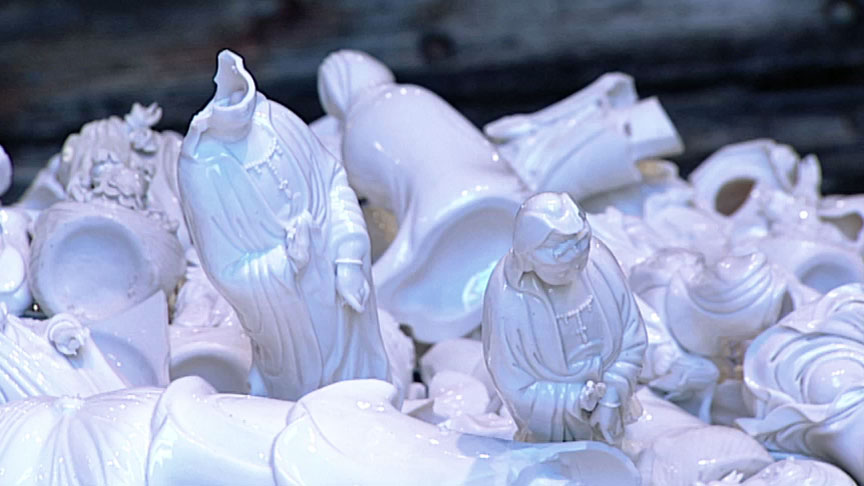
Cai Guo-Qiang. Reflection, 2004. Excavated boat, porcelains; 18 x 50 x 16 feet. Installation view at Freer Gallery of Art and Arthur M. Sackler Gallery, Smithsonian Institution, Washington D.C., 2005. Production still from the Art in the Twenty-First Century Season 3 episode, Power. Artwork courtesy of the artist. Photo © Art21, Inc. 2005.
Artist Cai Guo-Qiang discusses his 2004 sculptural installation Reflection.
ART21: Can you talk about how the Iwaki village in Japan has changed over time, from your visit many years ago to today, and how the boat piece, Reflection, came about?
CAI: This work arose out of a couple of interesting points in Japanese history. One is that Japan went through a period of transformation that’s probably very similar to what China is going through right now, except China is going through it in a very uneven way. There’s a difference between the rich and the poor, whereas Japan changed very rapidly, uniformly. All of a sudden, wooden boats were completely obsolete; they were replaced by iron, metal, and resin boats. And for me, it was a very shocking thing to see because in my hometown we still had wooden boats. In Japan you would see these beautiful little boats that looked and behaved just like wooden boats, but when you got up close, knocked on them, they actually made this hollow sound. When you pushed or pulled them they were very light. Whereas in my hometown it took many men to push a wooden boat into the ocean, here it was completely different.
In the Meiji period, Japan went through over a hundred years of modernization, which all came through western science, theories, and ideas. So, they felt like modern Japan was a product of western thought and influence. At this time, when I was going to Iwaki, there was a wave of new science coming out of San Francisco. The Japanese were quite excited by this. They thought that this was the time of the Pan Pacific, that a new age had come. So, there was a lot of excitement that got generated during this time. They felt that, here, Japan could truly have some kind of contribution to the world. That it was no longer a discussion of western culture or eastern culture, but that we could arise above these discussions; it would be a global community.
This was the background for where the exhibition happened. When I came to Iwaki, I came barehanded, with nothing. I wanted to begin a dialogue with the local people. I wanted to have a dialogue with the earth and the universe and the cosmos here. So, the idea was to start with nothing, to begin very local and to reach for something much grander in scale.
I inherited something that Chairman Mao passed down to us: create slogans that people can get behind. The slogan I came up with for Iwaki was: “Begin a story here. Create an artwork here. Begin a dialogue with the universe here. Create a story of this time with the people here.” The idea was that everything should begin here, in this location. We should forget discussions about globalization or the Pan Pacific. All these things could be put aside. What was important was that everything would begin with the people here and now. And we could have a dialogue with the universe at large.
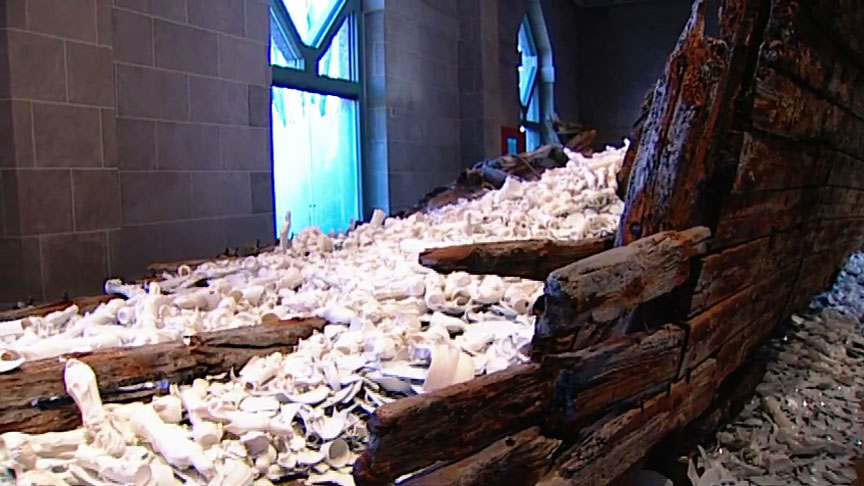
Cai Guo-Qiang. Reflection, 2004. Excavated boat, porcelains; 18 × 50 × 16 feet. Installation view at Freer Gallery of Art and Arthur M. Sackler Gallery, Smithsonian Institution, Washington D.C., 2005. Production still from the Art in the Twenty-First Century Season 3 episode, Power. Artwork courtesy of the artist. Photo © Art21, Inc. 2005.
ART21: Was it a shared artwork? Did everyone in the village participate?
CAI: The project was actually first known only by a small number of people. Slowly it was made known to the more general public. These people, the core group, first started working just out of the goodness of their hearts, just out of charity, because the museum had very little money. They just felt, like, maybe they could help out a little bit. But through the process of the project they became so involved, much more than they anticipated. They felt that through the project they found things that were very meaningful to them.
For example, in order to excavate this boat on the beach, we had to find the old ship makers of the village. They were very old, in their eighties, because that art is kind of lost. But we had to get them to come out to show us how and where to pull the boat. Also, how to cut it, so that the boat wouldn’t fall apart and could still be put back together again. These kinds of things revived some of the things that were lost.
And at the same time, I also made another piece on the horizon called, The Pan Pacific Horizon, which had five kilometers of gunpowder fuse ignited on the water to sketch out the horizon line between the ocean and sky. When we did this, I actually proposed this idea where any citizen of the city could purchase one meter of the gunpowder fuse with ten U.S. dollars. We ended up with a 5,000-meter-long fuse. Over 2,000 people participated and bought sections of it, so we had realized this through the help of these people. And the same time, they started this thing where they asked everybody along the coast in the area to turn off their lights during the project, because they thought the line would be much more believable. The project was part of the larger Project for Extraterrestrials. It’s meant as a message to the universe. The people understood it thoroughly and felt that, by turning off the lights, they could make the piece more complete and more beautiful. So, they were even participating in the creative process.
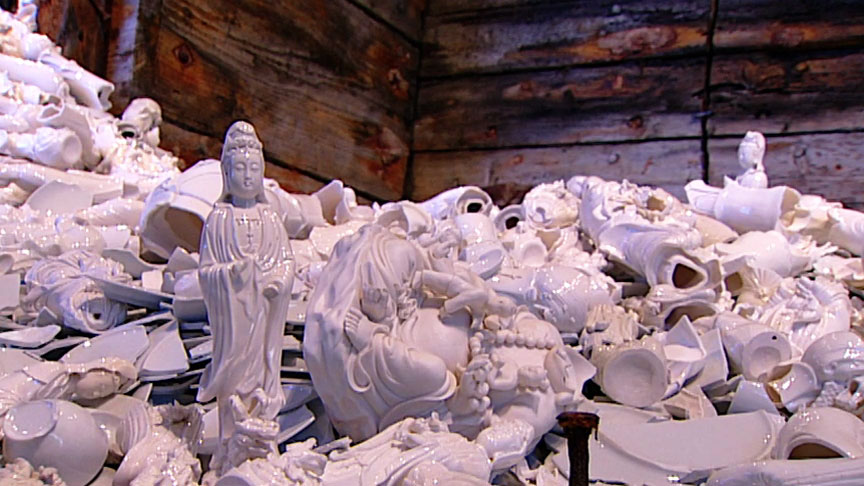
Cai Guo-Qiang. Reflection, 2004. Excavated boat, porcelains; 18 × 50 × 16 feet. Installation view at Freer Gallery of Art and Arthur M. Sackler Gallery, Smithsonian Institution, Washington D.C., 2005. Production still from the Art in the Twenty-First Century Season 3 episode, Power. Artwork courtesy of the artist. Photo © Art21, Inc. 2005.
ART21: Can you say more about Reflection—about the statuary, perhaps? What do the figures represent?
CAI: Kuan Yin is a god or goddess that I hold very close, a god that I worship. And when you say that, you’re relying on some kind of eternal power this figure has. However, when I look at the Kuan Yin statues in the museum, I see that they are artworks. I do not see them as gods and goddesses. They are artistic representations that are different from the types of idols that we use to draw a link between us and the eternal power of the deity. So here, in Reflection, we have a few tons of Kuan Yin figures, seen as artistic objects. They are placed here for that purpose. But of course, because of the nature of these statues, what they allude to brings on very strong emotions, and that becomes part of the richness of the work.
For me, it’s really important that the work here displays an aesthetic of decay, along with the sunken boat with the broken ceramic pieces. They form a unity in showing the power of destruction, the beauty of destruction, whether it’s from nature—because the boat has sunk—or through other forces. It’s really the beauty of decay and death that holds a power here.
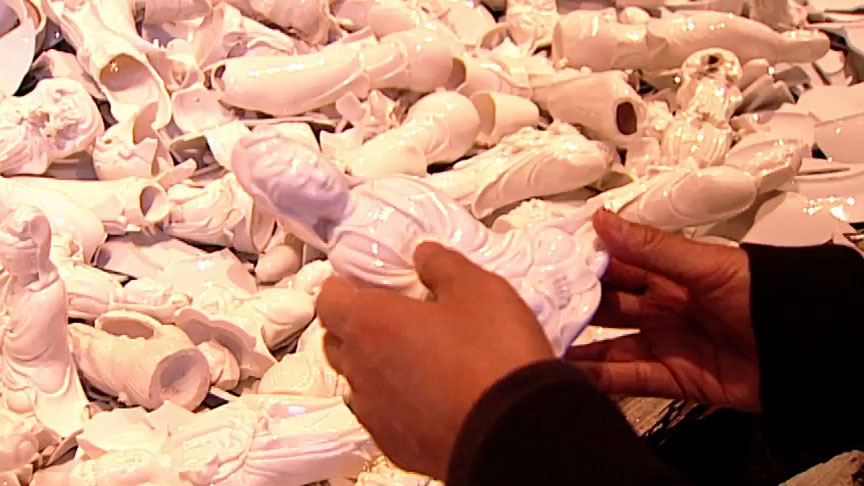
Cai Guo-Qiang. Reflection, 2004. Excavated boat, porcelains; 18 × 50 × 16 feet. Installation view at Freer Gallery of Art and Arthur M. Sackler Gallery, Smithsonian Institution, Washington D.C., 2005. Production still from the Art in the Twenty-First Century Season 3 episode, Power. Artwork courtesy of the artist. Photo © Art21, Inc. 2005.
ART21: So, the meaning and power that the statues have very much rely on context?
CAI: Dehua’s very well known for its white porcelain production; it’s the southern capital for porcelain in China. A number of years ago, I visited this factory in Dehua and saw all these statues that looked perfectly fine, but they were rejects. It could be a crack somewhere or a finger broken off or sometimes even a grain of sand. Because of these imperfections, the statues are no longer considered deities. I thought it was very strange that without these imperfections, these would be figures that people worshipped. It seemed so arbitrary. I thought it was such a waste, so I said, “I’ll buy these from you, at a fraction of the cost.” I’ve been looking for an appropriate place to use these for some time.
I’ve been sitting here thinking that I should take one of the Kuan Yin figures from this stack and put it in my studio. This Kuan Yin is what we call on to bless the home with a son, with a male heir. If this were at my home, it would seem appropriate; but in the studio, with all my staff there, maybe it’s not the most appropriate Kuan Yin to have. Here, I see them as artwork, like I said earlier; they don’t hold as much power as a deity. But if I take one and put it in the studio, I think very naturally my emotions will shift; I will see that as an object to be worshipped. And if I brought my Kuan Yin from home to here, the role will shift yet again; it will become an artwork and cease to be an object of worship, of ritual. I think this is really quite interesting; it’s very complex and there are a lot of nuances. And it’s very close to many things being discussed in contemporary art. This very fine line—what defines the nature of an object?
ART21: Can you describe how the Chinese principle of “anyway” relates to your work, or give an American analogy?
CAI: It’s difficult to say. Maybe the idea is like seeds and a field. A field is where you work and the weather is the climate, in the broader sense of climate—political, artistic, or otherwise. My approach in the way I farm is very much at ease. I know what the soil grows, I know what kind of weather comes when, and I know what these seeds are, but where the seeds fall and how it’s nurtured I let happen naturally. We take advantage of the climate, the weather, whether it’s rain or shine, and the temperature—these are all figured in. So, the approach is, in a very naturalistic way, going with nature to see what may be fostered, what may come out of the field and become fertilized.
This is a little bit abstract, but I think overall it’s a more holistic way that eastern philosophy looks at something. Things are always in a constant state of changing, shifting, and adjusting. We are constantly shifting and adjusting to the natural elements, so it’s not stagnant; it’s alive. It’s a living, breathing system.
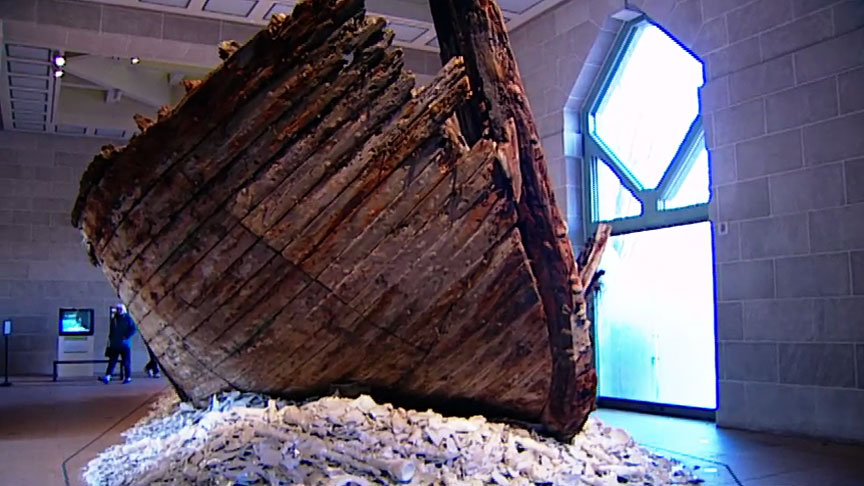
Cai Guo-Qiang. Reflection, 2004. Excavated boat, porcelains; 18 × 50 × 16 feet. Installation view at Freer Gallery of Art and Arthur M. Sackler Gallery, Smithsonian Institution, Washington D.C., 2005. Production still from the Art in the Twenty-First Century Season 3 episode, Power. Artwork courtesy of the artist. Photo © Art21, Inc. 2005.
ART21: It also seems like you rely on chance or luck in your work.
CAI: I had a streak of bad luck from 2003 to 2004, and it was told to me repeatedly, through various ways. Bad luck or unlucky things are in themselves a work; it is a work of a very neutral nature. I felt that it was actually very interesting to look at this. You are a person; you undergo all kinds of conditions and weather. When you have sun, on the other side you have shadow. You should look at what kind of fruit bears in the light as well as what conditions arise when you’re in the shadow. This is all very interesting for me as a person and as an artist. These are all fascinating things to examine and investigate.
This interview was originally published on PBS.org in September 2005 and was republished on Art21.org in November 2011.



